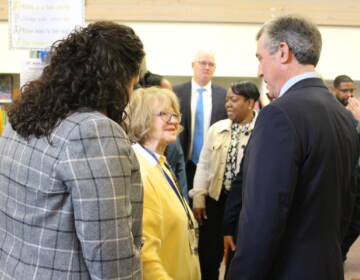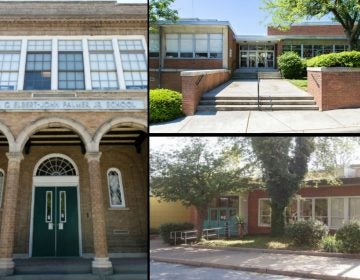Christina school closure plan met with concerns, resentment
Gov. John Carney's quest to improve high-poverty, low-performing Wilmington schools crystallized this week but not with a lots of criticism from parents.
Listen 1:53
Gov. John Carney faced a host of questions during a boisterous town hall meeting Wednesday at Stubbs Elementary School, one of three Wilmington school eyed for closing under a proposal by his administration and other education leaders. (Cris Barrish/WHYY)
Gov. John Carney’s quest to improve high-poverty, low-performing Wilmington schools crystallized this week with the unveiling of a plan to close three schools and expand two others in the Christina district.
But the proposal, which still needs several levels of approvals over the next few months, has met resistance and resentment on several fronts.
That was evident at a public meeting this week at Stubbs Elementary — one of the schools set for closure — after details of what had been the “confidential” plan were leaked to the media and published beforehand.
The governor has held three public meetings to gather and share ideas, including one this week at Stubbs Elementary on the city’s East Side. Stubbs is one of the three elementary schools slated for closure, along with Palmer and Pulaski.
But Carney faced some ire from parents and educators, who had read about plan and had plenty of questions, mostly about being left out the decision process.
Attendees also expressed concerns such as safety at the schools, teachers whom they said aren’t equipped to handle children who come from poverty and unstable households, and how they would get their children to a school farther from their homes.
The notion that their opinions weren’t valued was vocalized by a parent in the audience who addressed the crowd of about 200.
“For us to be told by the media that this is what the plan was behind closed doors and you guys are just going to have to go with it is just so disrespectful to us on so many levels,’’ she said to boisterous applause.
“If we are supposed to be partners in this situation then you should allow us to have a vote or say as to what’s going on.”
Carney, who had visited dozens of row homes in the high-crime neighborhood the previous night to invite residents to the meeting, told the audience he did so because he welcomed their input.
“I went knocking on doors not to hide anything from people but to hear from people their concerns as you just articulated to me,” the governor said.
“So we’ll take into consideration all the things we hear tonight.”
‘Unacceptably low’ performance
Since taking office in January, Carney has been looking for ways to improve struggling schools in poor Wilmington neighborhoods. His first major step was to target Christina’s five city schools – four K-5 buildings and a middle school for sixth-through eighth graders..
His administration, working with the district’s new superintendent, Richard Gregg, Christina’s teachers’ union and state education leaders, agreed to pursue a memorandum of understanding to improve that they agree is “unacceptably low” proficiency at the schools.
Gregg, who also addressed the crowd at the end of Wednesday’s meeting, criticized the media for publishing a working draft plan that hadn’t been finalized, saying numerous changes had been made.
Yet when proposal was published on the board’s website Thursday for its discussion at a meeting next Tuesday, the overarching plan had not changed.
It still calls for the three schools to be closed, and turned into resource centers for families. The centers would provide child care, job training and other services.
Their 900 students would be moved to Bancroft Elementary and Bayard Middle School, which would be reconfigured to serve children from kindergarten through eighth grade. The concept would be three schools within each three-story building — grades K-2 on the first floor, grades 3-5 on the second and 6-8 on the third.
Carney will ask lawmakers to provide millions to renovate those buildings and improve programs at those lawmakers.
For Pulaski parent Joyce Lewis, all that matters is improving educational opportunities for city kids.
“If you are doing it just to fill up space and consolidate just to close down to save money then that’s a bad idea,” Lewis said. “But if you are doing it where the children can grow and their behavior will develop in positivity, where we’re seeing kids actually function better, then it’s a good idea.”
On Tuesday the board can approve or reject the plan, or suggest changes that the other parties – district, state and union – can review and perhaps modify themselves.
The board will revisit the proposal on Dec. 12. But even if a version is approved then, the board will have until Feb. 28 to make any changes or reject the plan altogether.
WHYY is your source for fact-based, in-depth journalism and information. As a nonprofit organization, we rely on financial support from readers like you. Please give today.





